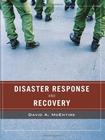灾难应对与恢复 Wiley Pathways Disaster Response and Recovery
2006-8
John Wiley & Sons Inc
David A. McEntire
498
Where do you want to go? You might already be working in the emergency management field, and may be looking to expand your skills. You might be setting out on a new career path. Or, you might want to learn more about exciting opportunities in emergency management. Wherever you want to go, Disaster Response and Recovery will help you get there. Easy-to-read, practical, and up-to-date, this text not only helps you learn fundamental emergency management concepts; it also helps you master the core competencies and skills you need to succeed in the classroom and beyond. The book’s brief, modular format and variety of built-in learning resources enable you to learn at your own pace and focus your studies.作者简介: David McEntire is an assistant professor of emergency administration and planning at the University of North Texas. His expertise includes: Disaster Prepardness Planning and reponse, Emergency Management, Terror Response, Disasters in Developing Nations, Disasters, Disaster Relief.
1. Knowing What to Expect: Hazards and Disasters Introduction 1.1 The Occurrence of Disasters 1.1.1 Important Concepts 1.1.2 Preview of Disaster Response and Recovery Self-Check 1.2 Types of Hazards 1.2.1 Natural Hazards 1.2.2 Atmospheric Hazards 1.2.3 Geological Hazards 1.2.4 Hydrologic Hazards 1.2.5 Seismic Hazards 1.2.6 Wildfire Hazards 1.2.7 Biological Hazards 1.2.8 Environmental Hazards Self-Check 1.3 Technological Hazards 1.3.1 Industrial Hazards 1.3.2 Structural Collapse Hazards 1.3.3 Nuclear Hazards 1.3.4 Computer Hazards 1.3.5 Transportation Hazards Self-Check 1.4 Civil/Conflict Hazards 1.4.1 Mass Shootings 1.4.2 Panic Behavior 1.4.3 Riots 1.4.4 Terrorism 1.4.5 War Self-Check 1.5 The Interaction of Hazards and Impact ot Disasters 1.5.1 The Nature of Disasters 1.5.2 Changes Associated With Disasters 1.5.3 The Need for Response and Recovery Operations Self-Check Summary Key Terms Summary Questions Review Questions Applying This Chapter You Try It2 Understanding the Actors: Role and Responsibilities of Disaster Participants Introduction 2.1 The Public Sector 2.1.1 Local Government 2.1.2 State Government 2.1.3 Federal Government Self-Check 2.2 The Private Sector 2.2.1 Emergency and Long-Term Medical Care 2.2.2 Sheltering and Construction 2.2.3 Media Reporting 2.2.4 Volunteers and Donations 2.2.5 Insurance Settlements 2.2.6 Utility Restoration 2.2.7 Business Continuity 2.2.8 Transportation 2.2.9 Vending of Goods and Services Self-Check 2.3 The Non-Profit Sector 2.3.1 The Red Cross 2,3.2 Faith-Based Organizations 2.3.3 Community Groups Self-Check 2.4 Citizen and Emergent Groups Self-Check 2.5 Working With Different Groups Self-Check Summary Key Terms Summary Questions Review Questions Applying This Chapter You Try It 3 Anticipating Human Behavior in Disasters: Myths, Exaggerations and Realities. 4 Approaching Response and Recovery Operations: Alternative Management Theories. 5 Responding with Initial Measures: Hazard Detection, Warning, Evacuation, and Sheltering. 6 Caring for the Injured, Dead and Distraught: Overcoming Physical and Emotional Impacts. 7 Managing Public Relations, Donations and Volunteers: Expected Challenges and Benefits. 8 Moving Beyond Immediate Needs: Damage Assessment, Disaster Declarations and Debris Removal. 9 Promoting Recovery and Mitigation: Disaster Assistance and Vulnerability Reduction. 10 Overcoming Typical Challenges: Other Anticipated Problems After Disaster. 11 Harnessing Technology and Organization: Tools for Local, State and Federal Governments. 12 Dealing with Future Disasters: Prior Lessons, New Threats and Rising Vulnerability. 13 Promoting Disaster Resilience: Preparedness, Improvisation, Professionalism and Leadership. Bibliography. Glossary. Index.

灾难应对与恢复 Wiley Pathways Disaster Response and Recovery PDF格式下载